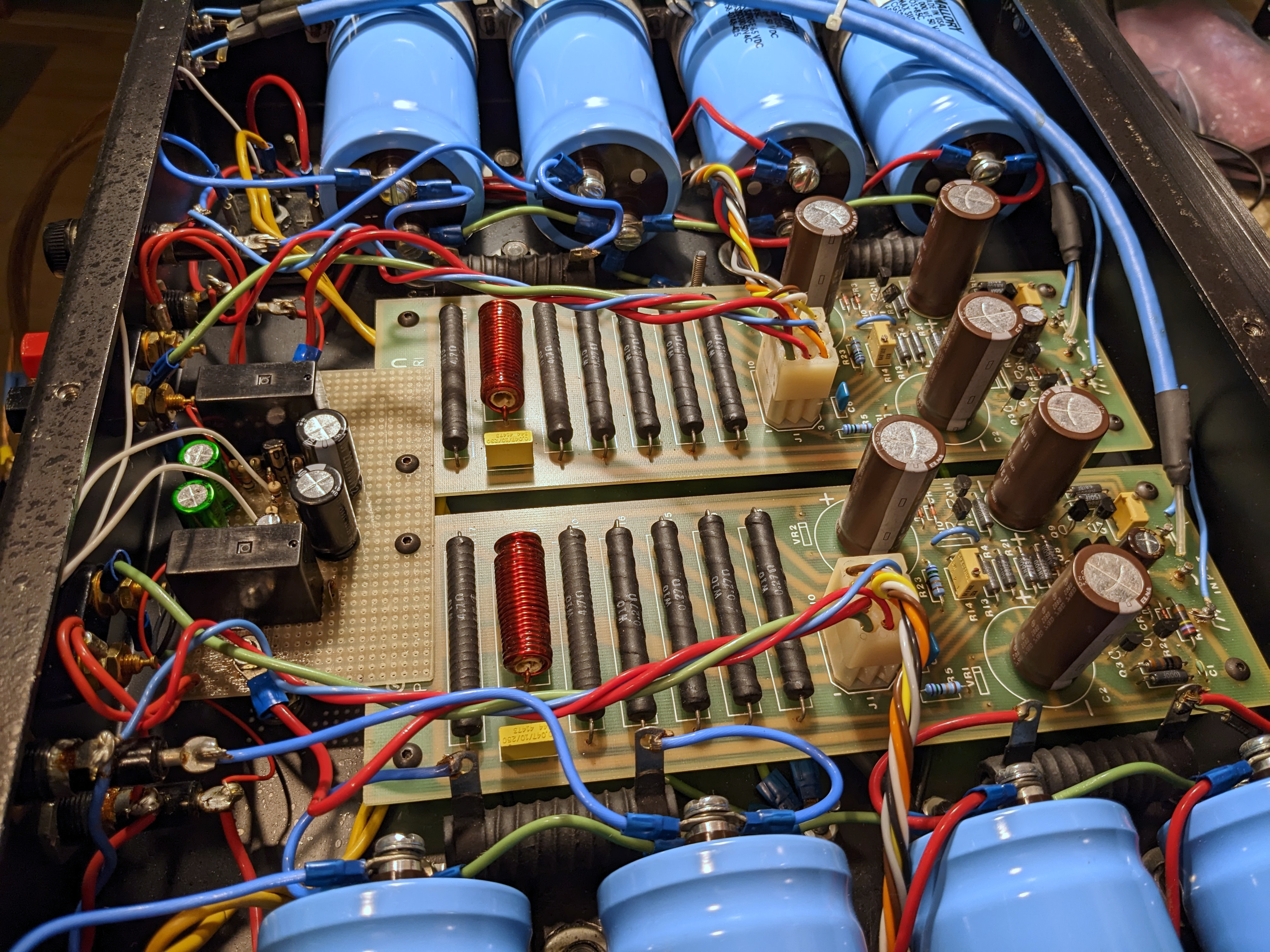Eleson PCA-100 - The Classe DR-2 Predecessor
Dave Reich built 60 of these between 1979 & 1980. They were designed to drive stacked Dayton-Wright speakers which were known to be very difficult loads (well below 1 Ohm). These amplifiers were only distributed to dealers in Montreal and Toronto and sold for around $1500 (although I don't know if it's Canadian or US dollars). Mr Reich's backers/partners/investors liked this amp so much that Classé Audio was formed. Classé is a play on words for Class A. Classé's first product (1980) was the DR-2; a refined version of the Eleson PCA-100. Those appear to be the facts as I know them.
This amplifier could be considered a DR-1 (I ased Mr. Reich in October of 2008). The outward appearance of the Eleson is similar to the DR-2/3. The most obvious difference is the faceplate - the Eleson uses a 2U panel and the DRs use a 6U panel - both are 1/4" thick. Also obvious are the heatsink "dust caps" - the Eleson uses perforated steel and the Classé has nicely machined, gold anodized aluminum pieces. Less obvious are the heatsinks - there are no mounting slots on the outer fins of the Classé units as there are on the Eleson. The thick steel chassis of these two amplifers appear to be identical right down to the black speckled paint.
The main difference between the PCA-100 and DR-2 appears to be in the transformers. If I recall correctly, the DR-2 had two custom wound transformers potted in a rectangular "box", giving the amplifier a more finished look. The Eleson used two large off-the-shelf Hammond units (approx 350W ea.), lending a very industrial look to the amp. The Eleson's transformers hum loudly! This is probably because they are hard-mounted on the chassis, and that they are supplying maximum power at all times for pure class A operation.
Electrically, the Eleson most closely resembles the DR-3 VHC. All transistors are the same in both units. The main circuits are very slightly different in the DC offset network and in the feedback network. Both amplifiers use the same output darlingtons and biasing network. One of the major differences between the two is that the VHC (and DR-3) make use of extensive capacitor bypassing (mounted on boards near the filter caps). The DR amps also have strapping circuts while the Eleson is stereo only.
Digging deeper into the circuits, the Eleson uses tantalum input coupling capacitors instead of film. I must admit that this is one of the first things I changed in this amplifier. The DR-2/3 use eight Mallory 20000uf 50V filter capacitors (the VHC uses 30000uf). Most of the resistors in the Eleson are mil-spec RN60s or 1/2W Rodersteins, while the others are wirewound power resistors. All wire is mil-spec teflon insulated, and the PC boards are of a high quality fiberglass. My amp was probably built in '79, and I have never seen such quality parts in a piece of gear of this vintage!
Like many of the amplifiers that I acquire, this one had problems that were not repaired correctly (or made worse) by the previous tech(s). As received, one channel had low volume and thermal runaway because the output devices on that channel were not the correct ones and were not matched (darlingtons cannot be matched using a transistor tester). I completely rebuilt this amplifier sometime around 2009 - 2010.
Here is some documentation:
The instructions in this manual should be used to set the bias and offset. Performing this proceedure takes considerable time and some muscle as well, since it requires flipping this 55lb amplifier upside down to adjust, and flipping it back upright to let the heatsinks settle...over and over until it meets spec.
While this is not a DR-2 schematic, the DR-3 VHC is very close to the DR-2 if you disregard two of the four pairs of output devices.
This DR-3 schematic was also drawn by Federico Paoletti (his Counterpoint SA-100 Schematic also appears on this site). Mr. Paoletti was involved in designing some very well-regarded equipment under the name Audio Analogue.
I posted this to the Audiogon Forum (woodmann) a long time ago. There is another post further down warning about forced-air cooling.
DC surge at powerup
Both the Eleson and DR-3 have a big DC surge on powerup that will make woofers extend to their fullest. I was alarmed at seeing a newly re-foamed woofer do this every time the amp was turned on, so I added a protection circuit. I used a pair of UPC1237 speaker protection ICs and a pair of 16A DPDT relays. The relays remain open for 30s after power up unless the sense resistor detects DC above a set threshold. Everything needed to build the circuit is in the spec sheet.
More Eleson PCA-100 and Classe Audio DR-3 pictures
High resolution detail images showing wiring, construction, parts, etc.






